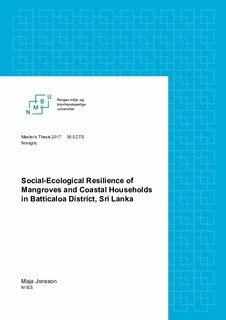| dc.description.abstract | This study compared two Social-Ecological Systems (SES) of mangroves and adjacent households, Sathurukondan and Nasivanthivu in Batticaloa District, with varied degrees of mangrove dependence, and different disturbance histories, but both involved in natural resource management projects. This study applied a mixed method approach, where ecological inventories were probability-sampled quantitatively and social dimensions were assessed qualitatively. Species diversity, forests characteristics, and structure data was derived from quadrats along transects perpendicular to the road and lagoon. The social data was collected through semi-structured interviews with households, key informants, and Fisheries Co-Operative Societies group discussions. The interviews were purposively sampled and thematically analyzed through coding and finally discussed in relation to principles of building SES resilience. The data indicate that insufficient tidal exchange in Sathurukondan cause dominancy of undesired mangrove species, E. agallocha, and mangrove associates that suggest ecological degradation. Nasivanthivu had higher functional mangrove species diversity caused by sound environmental conditions. Encroachment, accumulating waste, and erosion at lagoon edges were processes detracting from resilience at both locations. However, both mangrove forests are growing larger as a result from recent awareness program, replanting schemes, and increased monitoring. Most of these efforts are based on Participatory Coastal Zone Restoration and Sustainable Management Project that aims to restore coastal ecosystems through community participation and natural resource management. Further, as suggested from the context in Sathurukondan is access to urban areas increases substitution capacity in livelihood diversification and builds SES resilience. Further, social cohesion gives momentum to build resilience and adaptive capacity if properly embraced to wider governance networks for co-management or build capacity to self-organize in areas with low diversification flexibility, based from Nasivanthivu findings. There is large potential of building Social-Ecological-System resilience through diverse participation vertically and horizontally, sharing experience and information, open communication, mutual trust to maintain and agree upon desirable ecosystem services. However, incorporating participatory approaches and true local concerns may not be properly implemented, based from critique on hesitant devolution and internal social hierarchical structures within committees that sustain old top-down approaches. | nb_NO |

